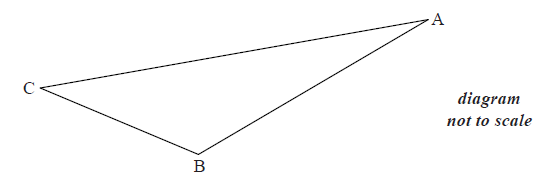| Date | May 2011 | Marks available | 6 | Reference code | 11M.1.sl.TZ1.9 |
| Level | SL only | Paper | 1 | Time zone | TZ1 |
| Command term | Show that and Hence | Question number | 9 | Adapted from | N/A |
Question
The following diagram shows the obtuse-angled triangle ABC such that \(\overrightarrow {{\rm{AB}}} = \left( {\begin{array}{*{20}{c}}
{ - 3}\\
0\\
{ - 4}
\end{array}} \right)\) and \(\overrightarrow {{\rm{AC}}} = \left( {\begin{array}{*{20}{c}}
{ - 2}\\
2\\
{ - 6}
\end{array}} \right)\) .

(i) Write down \(\overrightarrow {{\rm{BA}}} \) .
(ii) Find \(\overrightarrow {{\rm{BC}}} \) .
(i) Find \(\cos {\rm{A}}\widehat {\rm{B}}{\rm{C}}\) .
(ii) Hence, find \({\rm{sinA}}\widehat {\rm{B}}{\rm{C}}\) .
The point D is such that \(\overrightarrow {{\rm{CD}}} = \left( {\begin{array}{*{20}{c}}
{ - 4}\\
5\\
p
\end{array}} \right)\) , where \(p > 0\) .
(i) Given that \(\overrightarrow {|{\rm{CD}}|} = \sqrt {50} \) , show that \(p = 3\) .
(ii) Hence, show that \(\overrightarrow {{\rm{CD}}} \) is perpendicular to \(\overrightarrow {{\rm{BC}}} \) .
Markscheme
(i) \(\overrightarrow {{\rm{BA}}} = \left( {\begin{array}{*{20}{c}}
3\\
0\\
4
\end{array}} \right)\) A1 N1
(ii) evidence of combining vectors (M1)
e.g. \(\overrightarrow {{\rm{AB}}} + \overrightarrow {{\rm{BC}}} = \overrightarrow {{\rm{AC}}} \) , \(\overrightarrow {{\rm{BA}}} + \overrightarrow {{\rm{AC}}} \) , \(\left( {\begin{array}{*{20}{c}}
{ - 2}\\
2\\
{ - 6}
\end{array}} \right) - \left( {\begin{array}{*{20}{c}}
{ - 3}\\
0\\
{ - 4}
\end{array}} \right)\)
\(\overrightarrow {{\rm{BC}}} = \left( {\begin{array}{*{20}{c}}
1\\
2\\
{ - 2}
\end{array}} \right)\) A1 N2
[3 marks]
(i) METHOD 1
finding \(\overrightarrow {{\rm{BA}}} \bullet \overrightarrow {{\rm{BC}}} \) , \(|\overrightarrow {{\rm{BA}}} |\) , \(|\overrightarrow {{\rm{BC}}} |\)
e.g. \(\overrightarrow {{\rm{BA}}} \bullet \overrightarrow {{\rm{BC}}} = 3 \times 1 + 0 + 4 \times - 2\) , \(\overrightarrow {|{\rm{BA}}} | = \sqrt {{3^2} + {4^2}} \) , \(\overrightarrow {|{\rm{BC}}} | = 3\)
substituting into formula for \(\cos \theta \) M1
e.g. \(\frac{{3 \times 1 + 0 + 4 \times - 2}}{{3\sqrt {{3^2} + 0 + {4^2}} }}\) , \(\frac{{ - 5}}{{5 \times 3}}\)
\(cos {\rm{A}}\widehat {\rm{B}}{\rm{C}} = - \frac{5}{{15}}\) \(\left( { = - \frac{1}{3}} \right)\) A1 N3
METHOD 2
finding \(|\overrightarrow {{\rm{AC}}} |\) , \(|\overrightarrow {{\rm{BA}}} |\) , \(|\overrightarrow {{\rm{BC}}} |\) (A1)(A1)(A1)
e.g. \(|\overrightarrow {{\rm{AC}}} | = \sqrt {{2^2} + {2^2} + {6^2}} \) , \(|\overrightarrow {{\rm{BA}}} | = \sqrt {{3^2} + {4^2}} \) , \(|\overrightarrow {{\rm{BC}}} | = 3\)
substituting into cosine rule M1
e.g. \(\frac{{{5^2} + {3^2} - {{\left( {\sqrt {44} } \right)}^2}}}{{2 \times 5 \times 3}}\) , \(\frac{{25 + 9 - 44}}{{30}}\)
\(\cos {\rm{A}}\widehat {\rm{B}}{\rm{C}} = - \frac{{10}}{{30}}\) \(\left( { = - \frac{1}{3}} \right)\) A1 N3
(ii) evidence of using Pythagoras (M1)
e.g. right-angled triangle with values, \({\sin ^2}x + {\cos ^2}x = 1\)
\(\sin {\rm{A}}\widehat {\rm{B}}{\rm{C}} = \frac{{\sqrt 8 }}{3}\) \(\left( { = \frac{{2\sqrt 2 }}{3}} \right)\) A1 N2
[7 marks]
(i) attempt to find an expression for \(|\overrightarrow {{\rm{CD}}} |\) (M1)
e.g. \(\sqrt {{{( - 4)}^2} + {5^2} + {p^2}} \) , \(|\overrightarrow {{\rm{CD}}} {|^2} = {4^2} + {5^2} + {p^2}\)
correct equation A1
e.g. \(\sqrt {{{( - 4)}^2} + {5^2} + {p^2}} = \sqrt {50} \) , \({4^2} + {5^2} + {p^2} = 50\)
\({p^2} = 9\) A1
\(p = 3\) AG N0
(ii) evidence of scalar product (M1)
e.g. \(\left( {\begin{array}{*{20}{c}}
{ - 4}\\
5\\
3
\end{array}} \right) \bullet \left( {\begin{array}{*{20}{c}}
1\\
2\\
{ - 2}
\end{array}} \right)\) , \(\overrightarrow {{\rm{CD}}} \bullet \overrightarrow {{\rm{BC}}} \)
correct substitution
e.g. \( - 4 \times 1 + 5 \times 2 + 3 \times - 2\) , \( - 4 + 10 - 6\) A1
\(\overrightarrow {{\rm{CD}}} \bullet \overrightarrow {{\rm{BC}}} = 0\) A1
\(\overrightarrow {{\rm{CD}}} \) is perpendicular to \(\overrightarrow {{\rm{BC}}} \) AG N0
[6 marks]
Examiners report
Many candidates answered (a) correctly, although some reversed the vectors when finding \(\overrightarrow {{\rm{BC}}} \) , while others miscopied the vectors from the question paper.
Students had no difficulty finding the scalar product and magnitudes of the vectors used in finding the cosine. However, few recognized that \(\overrightarrow {{\rm{BA}}} \) is the vector to apply in the formula to find the cosine value. Most used \(\overrightarrow {{\rm{AB}}} \) to obtain a positive cosine, which neglects that the angle is obtuse and thus has a negative cosine. Surprisingly few students could then take a value for cosine and use it to find a value for sine. Most left (bii) blank entirely.
Part (c) proved accessible for many candidates. Some created an expression for \(|\overrightarrow {{\rm{CD}}} |\) and then substituted the given \(p = 3\) to obtain \(\sqrt {50} \) , which does not satisfy the "show that" instruction. Many students recognized that the scalar product must be zero for vectors to be perpendicular, and most provided the supporting calculations.

